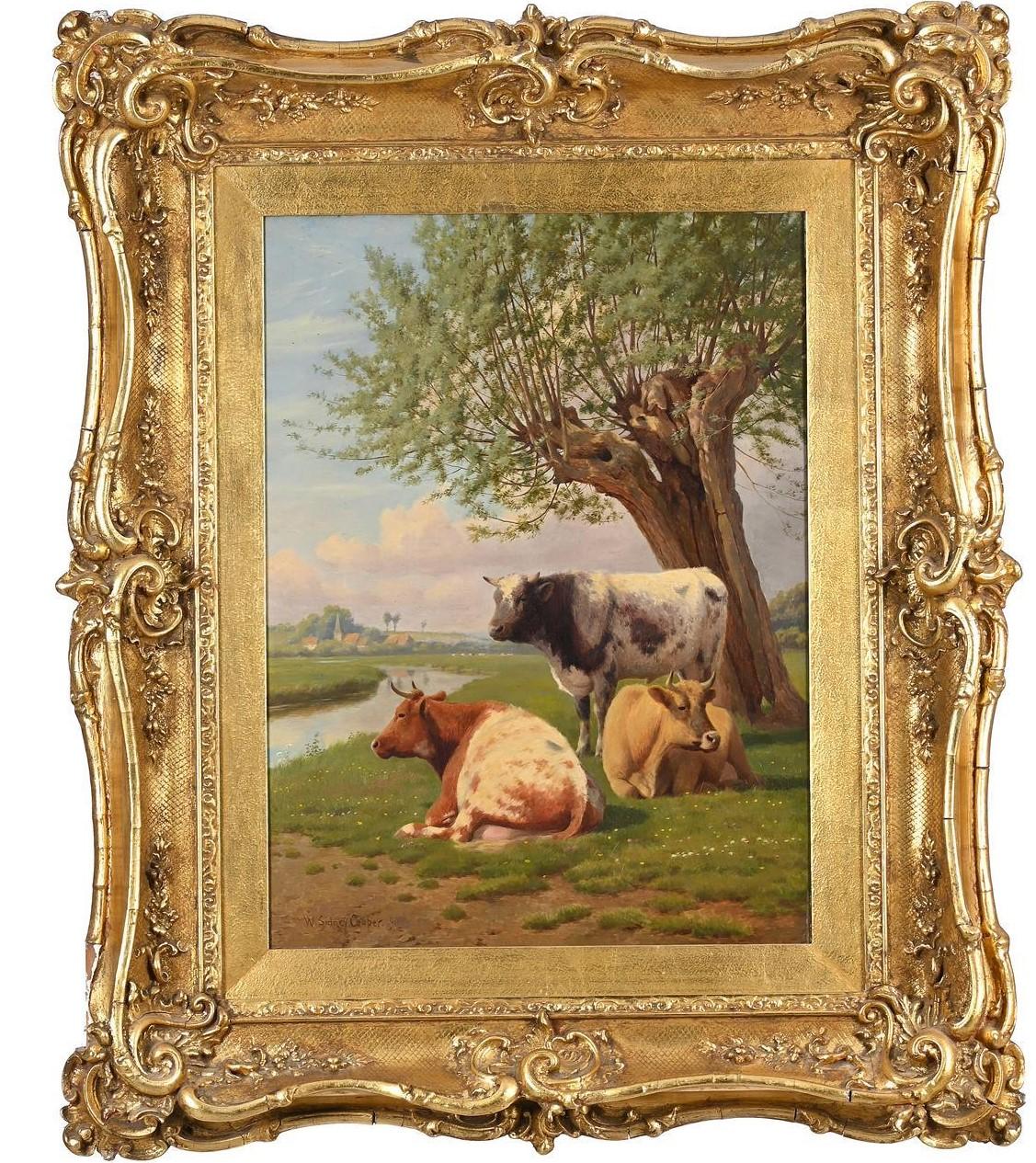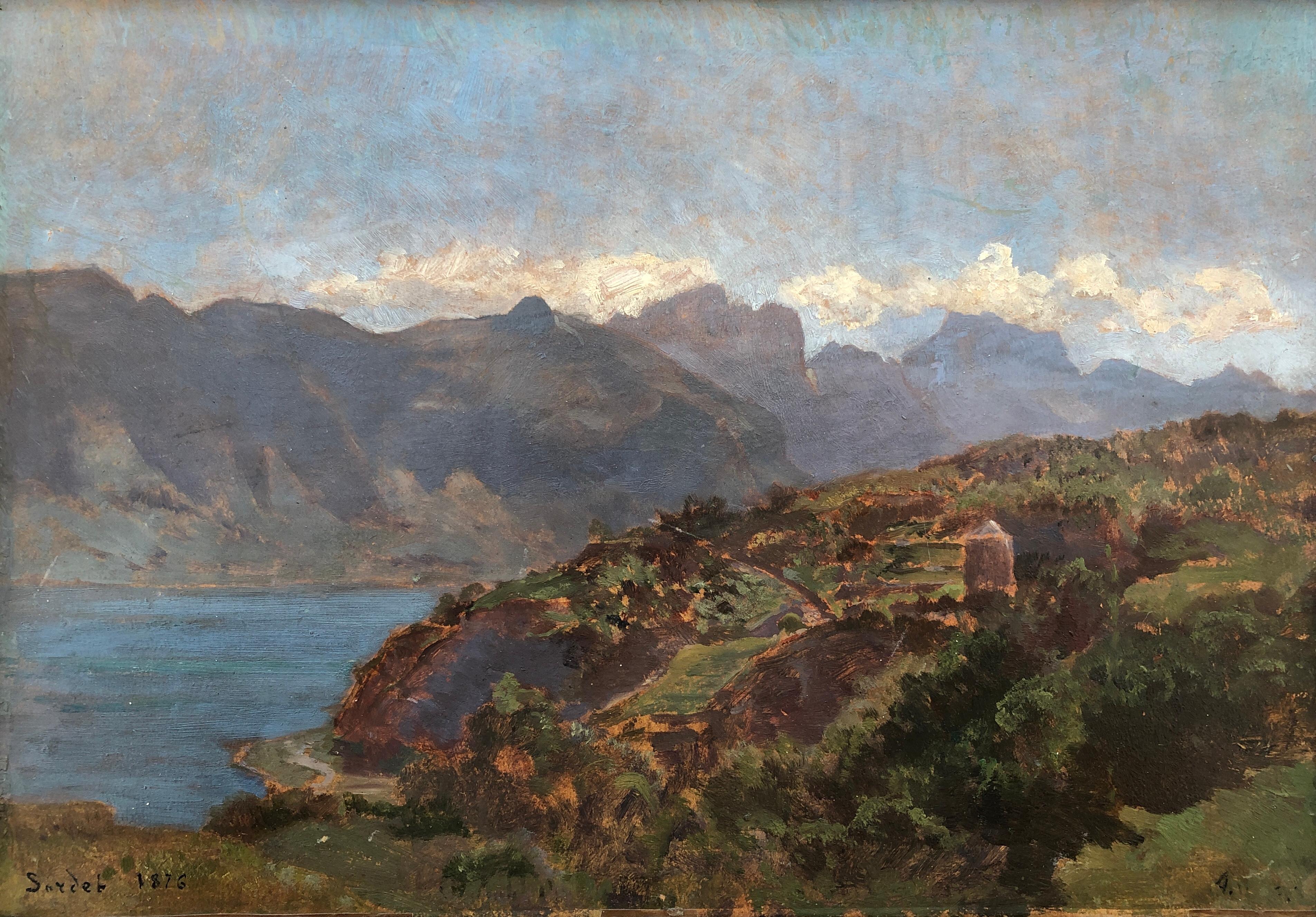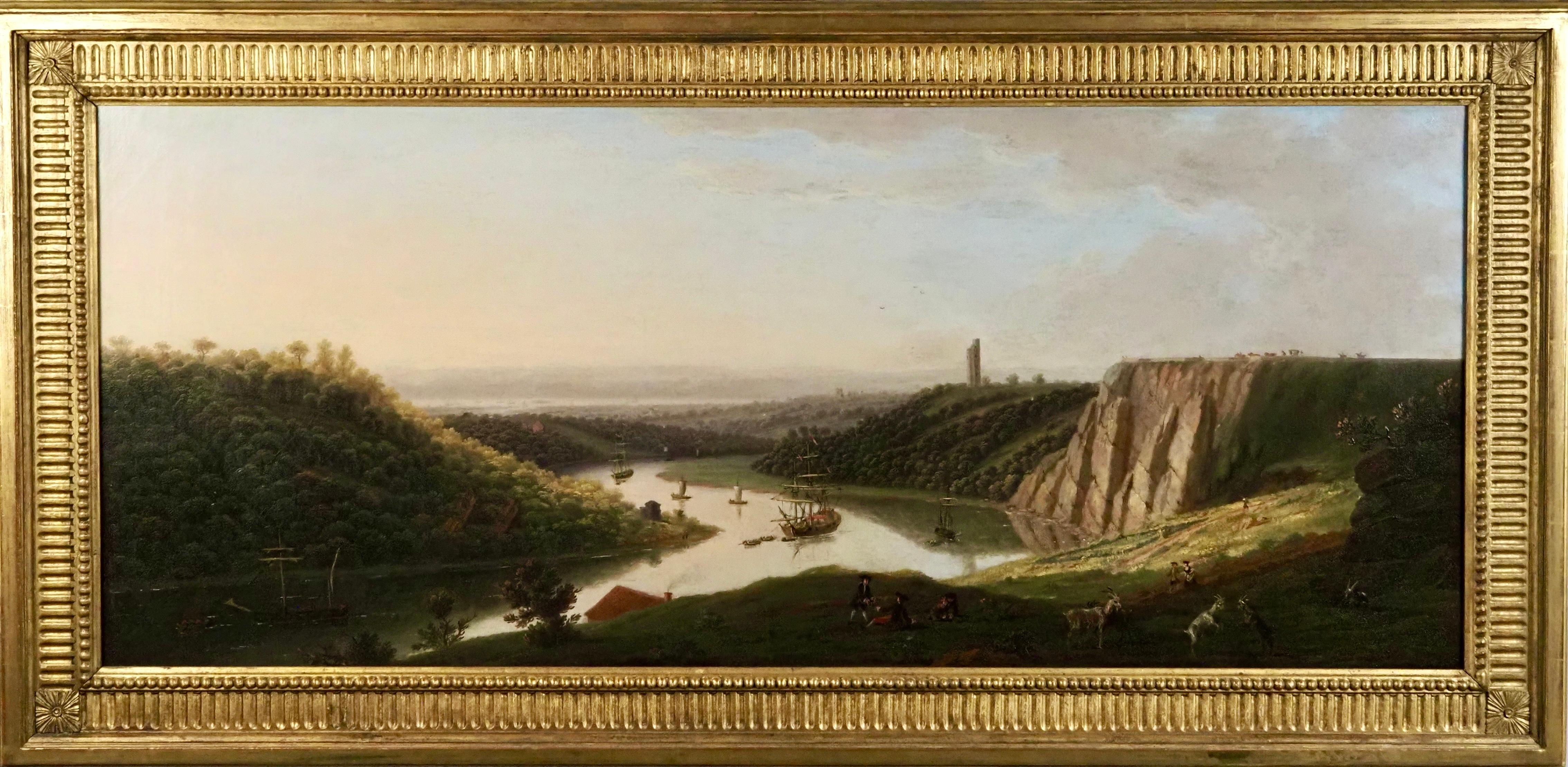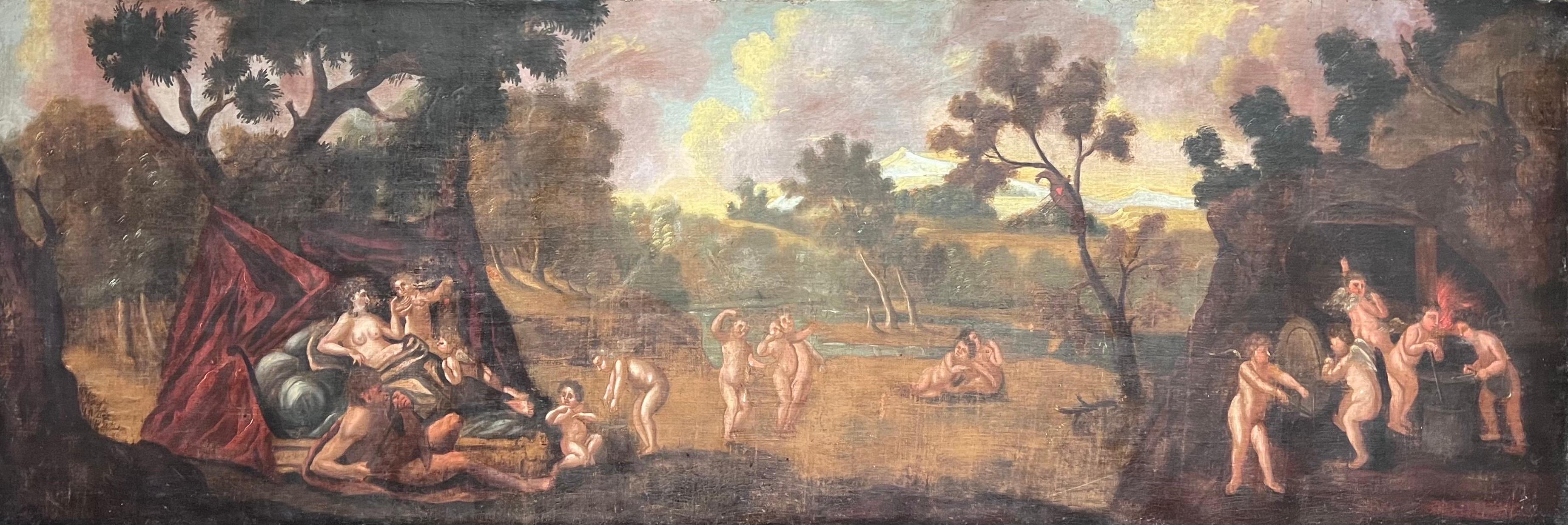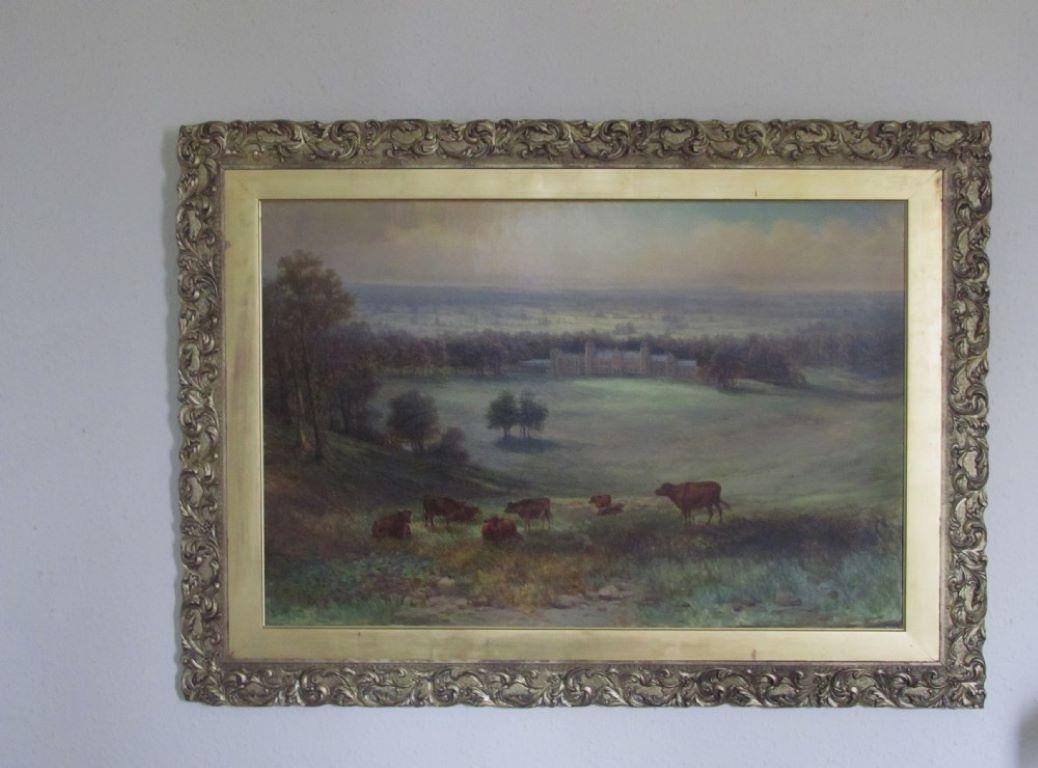Items Similar to Old Master Wooded Landscape - Irish 1830 art woodland oil painting
Want more images or videos?
Request additional images or videos from the seller
1 of 7
Old Master Wooded Landscape - Irish 1830 art woodland oil painting circa 1830
circa 1830
About the Item
A delightful large oil on canvas of a wooded landscape which dates to circa 1830 and is attributed to Irish artist James Arthur O’Connor. A superb painting and an excellent example of his work.
Provenance. Sotheby's London
Condition. Oil on canvas, 30 inches by 25 inches unframed and in good condition.
Housed in a fine carved frame, 38 by 33 inches framed. Very good condition.
James O'Connor was born in 1792, the son of William O'Connor, an engraver and print-seller who carried on business at No. 9 Exchequer Street, and, from 1791, at No. 15 Aston's Quay. James O'Connor, beyond some lessons he is said to have received from William Sadler (q.v.), was self-taught as an artist. His early works were compositions; his first studies from nature were made in the Dargle where he delighted in portraying its rocks and tangled foliage and rushing waters. In 1809 he commenced to exhibit, sending from 13 Aston's Quay an oil sketch, "Card-players," to the exhibition held in the Dublin Society's House in Hawkins Street. He continued to exhibit there until 1821, with the exception of the years 1816 and 1817, his contributions being mostly landscape compositions. In 1810 he published three etchings of figures, which were described in the "Hibernian Magazine" "as the first productions of a young and, as we have some reason to believe, a self-taught artist." He had formed a friendship with George Petrie and Francis Danby, to the latter of whom he had given some instruction in painting, and the three young artists determined to pay a visit to London. They arrived there in June, 1813; but their want of means made their stay a short one. Petrie returned to Ireland, and O'Connor and Danby set out on foot for Bristol where they arrived penniless. By the sale of some drawings Danby enabled O'Connor to return to Dublin; he himself remaining. On his return, O'Connor settled down as a landscape painter at 15 Aston's Quay, and later, in 1819, at No. 18 Dawson Street. He painted the scenery of Wicklow and the neighbourhood of Dublin, and in 1818 and 1819 was in the west of Ireland where he was patronized by Lord Sligo and Lord Clanricarde, for both of whom he painted a number of pictures of local scenery, views about Westport and Portumna. In 1820 he was awarded a premium of 25 guineas by the R.I. Institute. Though he worked hard he found but little demand for his pictures in Dublin; he had married, and, anxious to improve his prospects, he left Ireland and went to London. He began to exhibit at the Royal Academy the year of his arrival, 1822, and found some sale for his works. He continued as a constant exhibitor both at the Academy and at the British Institution until 1840, and also at the Society of British Artists, of which he was a member. He contributed to the Royal Hibernian Academy only twice, in 1836 and 1840; but a number of his works were exhibited there in 1842 and 1843, after his death. In 1826 he went to Brussels where he remained a year, and was successful in disposing of many of his pictures. In 1832 he was in Paris where he stayed eight months, leaving in May, 1833, when, accompanied by his wife, he visited Chalons, Saarbruck, Saarlouis and Metlach, and thence to Treves and down the Moselle to Coblentz and on to Mayence and Frankfort, returning to London in November, 1833. During this tour he painted some of his best pictures. In London he laboured incessantly, but with small success. He suffered from weak sight, and in 1839 his health began to fail. His inability to work involved him in pecuniary embarrassments, and, after a life of struggle and disappointment, he died in humble lodgings at No. 6 Marlborough Street, College Street, Brompton, on 7th January, 1841. He left a widow unprovided for. A subscription, headed with twenty guineas from the Prince Consort, was started for her benefit in 1845. O'Connor was a painter of deep feeling; his landscapes are solidly and vividly executed and are good in tone and colour. He was happy in the delineation of wild scenery and richly wooded landscapes, often with early morning or moonlight effects, in which he excelled. He was fond of introducing small figures in red coats or dresses into his landscapes. Most of his work was in oil, but he occasionally worked in water-colour. His works are housed in many National Collections.
- Attributed to:James Arthur O'Connor (1792 - 1841)
- Creation Year:circa 1830
- Dimensions:Height: 33 in (83.82 cm)Width: 38 in (96.52 cm)Depth: 2 in (5.08 cm)
- Medium:
- Movement & Style:
- Period:
- Condition:
- Gallery Location:London, GB
- Reference Number:1stDibs: LU853113392492
About the Seller
5.0
Platinum Seller
These expertly vetted sellers are 1stDibs' most experienced sellers and are rated highest by our customers.
1stDibs seller since 2018
402 sales on 1stDibs
Typical response time: 1 hour
- ShippingRetrieving quote...Ships From: London, United Kingdom
- Return PolicyA return for this item may be initiated within 14 days of delivery.
More From This SellerView All
- Travellers and Carriage in Landscape Dutch 17th century Golden Age oil paintingLocated in London, GBThis superb Dutch Old Master Golden Age oil painting is attributed to Pieter Bodding van Laer. Painted circa 1635 the composition is a group of travellers who have stopped to rest. I...Category
17th Century Old Masters Landscape Paintings
MaterialsOil
- Amsterdam Harbour Scene with Figures Dutch 17th Century art marine oil paintingLocated in London, GBThis superb Dutch 17th century Golden Age Old Master cityscape oil painting of Amsterdam is by noted artist Jacobus Storck. Painted circa 1670, the composition is a Dutch Amsterdam h...Category
17th Century Old Masters Landscape Paintings
MaterialsOil
- Arcadian Italian Landscape - Old Master 17thC French oil painting herdsman sheepBy (Attributed to) Gaspard DughetLocated in London, GBA delicate oil on canvas landscape capriccio of an Arcadian landscape with figures and sheep and goats in the foreground. A stormy sky and blasted tree populate the landscape and the...Category
17th Century Old Masters Landscape Paintings
MaterialsOil
- Dutch Marine Shipping Seascape - Golden Age art Old Master oil painting boatsLocated in London, GBThis superb Dutch Old Master marine oil painting is attributed to the circle of Jacob de Heusch. Painted circa 1690 the setting is an Italian coast with fisherfolk in the foreground....Category
17th Century Old Masters Landscape Paintings
MaterialsOil
- Peacock and Birds in a Landscape - British 17thC Old Master animal oil paintingBy Marmaduke CradockLocated in London, GBThis stunning British Old Master oil painting is attributed to circle of noted bird painter Marmaduke Cradock. Painted circa 1690 it is an excellent example and the sort of collection of birds he loved to paint - a peacock, wild turkeys, a jay in the foreground and doves, all set in a beautiful landscape. A variant of this painting is now in The Tate collection. Unlike many artists, he preferred to paint live birds with all their passions, joys and quarrels. The artist has perfectly capture the dynamics between this group, especially the dove and jay, as they all begin to settle down in the twilight. The colouring and brushwork are superb making this a fantastic British Old Master bird oil painting in a stunning carved gilt frame. Provenance. London estate. Condition. Oil on canvas, 42 inches by 39 inches and in good condition. Frame. Housed in a magnificent complementary period carved and gilded frame, 50 inches by 47 inches and in good condition. Marmaduke Cradock (1660-1716) was an English painter of birds and animals. Some older sources give his first name as Luke. Cradock was an English painter, noted for his depictions of birds, dead game, and other animals. He was born in Somerton, Somerset and moved to London, where he served an apprenticeship to a house-painter. He was, however, self-taught as an artist, becoming skilled in the depiction of birds and animals. Horace Walpole wrote that "I have seen some pieces by his hand which he painted with a freedom and a fire that entitled them to more distinction". According to Walpole, Cradock deliberately shunned aristocratic patronage. He worked in general by the day, and for dealers who retailed his works; possessing that conscious dignity of talent which made him hate to be employed by men whose birth and fortune confined his fancy, and restrained his freedom. According to the RKD his work as a still life and bird painter was influenced by Melchior d'Hondecoeter, Peter Frans Casteels, and Jakob Bogdani. Sketches in the collection of the British Museum indicate that he based at least some of the birds in his paintings on drawings from life. He tended to paint domestic birds and common wild species, rather than the exotic varieties favoured by some other artists. He sometimes introduced elements of drama such as attacks by predatory animals into his bird paintings, a feature shared with the works of Francis Barlow...Category
17th Century Old Masters Animal Paintings
MaterialsOil
- Tivoli Waterfall through Ponte Lupo - British Old Master landscape oil paintingLocated in London, GBThis superb exhibited British 18th century Old Master Italian landscape oil painting is by noted artist Thomas Barker of Bath. Painted in 1794 and exhibited at the Royal Academy in 1...Category
18th Century Old Masters Landscape Paintings
MaterialsOil
You May Also Like
- William sidney cooper, Cows by a river 19th century landscape oilBy William Sidney CooperLocated in York, GBA fine framed oil on canvas painting by the renowned artist William Sidney coope.Signed and dated 91 lower left. This painting depicts 3 cows resting by a river, a village with hous...Category
19th Century Old Masters Landscape Paintings
MaterialsOil
- Lake Annecy, the TournetteLocated in Genève, GEWork on cardboard Golden wooden frame 35.5 x 49 x 2 cmCategory
1870s Old Masters Landscape Paintings
MaterialsOil
- Attributed to John Riley, 17th century English portrait of a girl on a terraceBy John RileyLocated in Bath, SomersetPortrait of a young girl, full-length, wearing a blue silk gown, standing on a terrace beside a classical urn holding a branch with blossom. Attributed to John Riley...Category
17th Century Old Masters Portrait Paintings
MaterialsOil, Canvas
- View of Shipping on the River Avon from Durdham Down, near BristolLocated in Stoke, HampshireThomas Smith of Derby (c. 1710-1767) View of Shipping on the River Avon from Durdham Down, near Bristol, 1756 Oil on canvas Canvas size - 20 x 47 in Framed size - 26 x 53 in Provena...Category
18th Century Old Masters Landscape Paintings
MaterialsOil
- Huge Old Master Oil Painting 17th century Diana & Cupids in Panoramic LandscapeLocated in Cirencester, GloucestershireDiana The Huntress and her Cherubs Northern European artist, circa 1680's period oil on canvas, unframed canvas: 20 x 60.5 inches provenance: private collection, UK condition: some p...Category
17th Century Old Masters Figurative Paintings
MaterialsOil
- 19th Century, Victorian, landscape , cows , Country House Samuel Lawson BoothLocated in York, GBS Lawson Booth : Country House in extensive landscape with cattle in the foreground, oil on canvas signed and dated '98, 60cm x 90cm (35x23 inches approx image) size with frame appro...Category
19th Century Old Masters Landscape Paintings
MaterialsOil
Recently Viewed
View AllMore Ways To Browse
Antique Art Sale
Large Old Master
Master Of The Die
Friendship Art
Old Master Etchings
Old Pictures
Antique Oil Painting Red
View Master Antique
Antique View Master
Old Antique Dresses
Red Antique Landscape
Woodland Landscape
Ireland Landscape Painting
James West
Set 9 Paintings
7th Art
House Ireland
18th Landscape Oil
